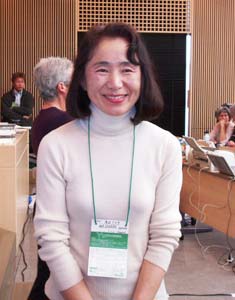Japan: First National Level Election Win
Share
Japan: First National Level Election Win
Optimism For Forming National Party
by Satoko Watanabe
Kagawa Prefecture MP, Co-Spokesperson of the Rainbow and Greens Japan
 “In the most recent municipal and prefecture elections, candidates from the Rainbow and Greens and the Greens Japan together won 122 seats in local assemblies out of the 159 races they contested.”
“In the most recent municipal and prefecture elections, candidates from the Rainbow and Greens and the Greens Japan together won 122 seats in local assemblies out of the 159 races they contested.”
The history of the Greens Japan and the Rainbow and Greens Japan
For many years going back to the early 1990s, there have been various attempts to form an official Green Party in Japan. But the high barriers of the Japanese electoral system have made starting a new party difficult. Recent efforts by grassroots Greens however are bringing this dream ever closer to fruition.
Currently two Japanese Green movement groups participate in electoral politics. The older is the Rainbow and Greens Japan, founded in 1998, as a network of Green-thinking independent local politicians and active citizens longing for political reform. They started with about 250 members, including 120 local legislators, and the Mayor of Hiroshima as an honorary member.
Many then attended the 2001 Global Greens meeting in Canberra, Australia, giving themselves a chance to identify as Greens before the global Green community. Their positive experience there encouraged them to further pursue Green politics in Japan, leading to their offering to host the historic Asia Pacific Green Network meeting in February 2005 in Kyoto. Held just days before the effective start date of the Kyoto Protocol Treaty on Climate Change, that meeting was attended by more than 100 Greens from 23 Asian and Pacific nations, along with 300 more from Japan and Green observers from Europe and the Americas.
In 2002, a second group, Environmental Party Greens Japan, was founded with the intent of preparing to start a Green Party of Japan. Its founder, Mr. Atsuo Nakamura ó a famous actor and writer was already at that time a member of the House of Councilors (the Upper House in the Diet, the national legislature of Japan.) How ever, Nakamura had not been elected as a Green, but as a member of the Pioneer Party.
Before he faced re-election in 2004, Nakamura formed the Environmental Party Greens out of the Pioneer Party and drafted nine others to run on his party list. Together they received about 900,000 votes (1.62%) ó short to the 2% needed to win seats and be certified as an official political party for the next national election. As a result, Nakamura lost his seat. Despite this, the network that grew around the campaign resulted in the founding of the Greens Japan in 2005. Today Green Japan has about 600 members, including 66 local councilors. Some members belong to both the Rainbow and Greens Japan and the Greens Japan.
Success on the local level
In the April 2007 municipal and prefecture elections, candidates from the Rain bow and Greens and the Greens Japan together won 122 seats in local assemblies out of the 159 races they contested (76.7%). Their campaign included environment, welfare, peace, and democratization of assemblies and abolishment of unnecessary privileges of politicians. Among those elected were six aged 35 and under, including Kazumi Inamura, the co-spokesperson of the Greens Japan.
The greatest success came in larger cities where higher percentages of younger and progressive voters exist, and in districts with many seats. By contrast, Greens were not successful in the cities of Kyoto, Fukuoka, and Niigata, where electoral districts have been divided into very small, winner-take-all wards with a limited number of seats in each, making it difficult for minor political groups to win.
Like in many places, big money and big endorsements also help decide who will win, and most Green candidates had neither. In addition, many towns and cities merged and reduced the number of seats available, which also adversely affected Green candidates.
Ironically, many candidates who were determined to run openly as Greens instead of as independents were not elected This suggests that Green politics may not be known well enough to attract voters in Japan, and that more organizing around issues and actions needs to occur between elections.
First Green elected on the national level
While Greens are able to run on a local level, the barriers to participation in elections to the Diet are much higher. For example, on a positive note, there is proportional representation for 96 seats out of 242 in the House of Councilors, with half elected every three years. Yet to even contest these seats, a party is required to at least run 10 candidates and put down a deposit of 60 million Yen (US $52,000). Then the party would need more money for the election campaign itself. This is something the Japanese Greens are not yet prepared to undertake. Therefore they decided to run as an independent candidate, internationally known Mr. Ryuhei Kawada, 31-year-old HIV-positive human rights activist, who a few months before had attended the Global Young Greens meeting in Nairobi, Kenya.
Kawada ran in a five-seat, winner-take-all district in Tokyo and conducted a spirited campaign in the streets of Tokyo, giving inspirational speeches about his personal experiences as a victim of HIV-infected blood product, his fight against the government and the company that infected him. Often moving audiences to tears, his campaign garnered increasing media attention that was unusual for an independent candidate, and attracted many young volunteers normally indifferent to politics.
On Election Day, Ryuhei won 683,629 votes, finishing fifth place out of five seats, and defeating the incumbent ruling Liberal Democratic Party candidate. The Greens Japan and the Rainbow and Greens Japan functioned as the main promoters for his victory. At the same time, many new volunteers came to Ryuhei’s campaign, leading to the hope they will be inspired to stay involved with Green politics.
Ryuhei’s first action as a member of the Diet was the visit to the Kashiwazaki nuclear power plant, which was damaged and temporarily shut down after a July 16th earthquake registering 6.8 on the Richter scale. Accompanying him were NGO members who will be come his chief advisors for his anti-nuclear-power-plant policies.
Ryuhei next staged a workshop on the pa tients’ rights for the members of the Diet. As he seeks to introduce and pass future legislation to protect peo ple’s health and rights, his prior ex perience confronting the Health and Wel fare Ministry will be extremely valuable.
Then on September 27, Ryuhei visited the Burmese Embassy in Tokyo to protest the Burmese military regime’s brutal suppression of its country’s democratization movement. He added that Japan is also responsible for the situation, since the Japanese government has long de facto endorsed the military regime, by being one of its biggest suppliers of official development aid. “The Japanese government tends to put more importance on financial benefits than on human rights issues,” he said “and it has not played a very active role in solving this kind of problem in the international community.” Ryuhei pledged himself to make the government change its foreign policy. Ultimately, there are 242 members in the Upper House, and as one of 242, it will not be easy for Ryuhei to realize his ideals. However, he is seen by many as a small but powerful Green seed in the Diet, and has become a symbol of the Green hope for the Green movement across Japan.
The move towards a national Green Party of Japan
Following the election, Rainbow and Greens and Greens Japan each had successful general meetings in August, and decided to merge to advance towards founding an official Green Party of Japan in about a year.
Perhaps the biggest challenge a new Green Party of Japan will face is that Japanese people are deeply disillusioned with politics and political parties. Corruption scandals occur one after another, and people tend to think politicians form new parties not for political philosophy, but for ambition. Through policies and actions Japanese Greens must prove they are different.
At the same time, the failure of Japan’s establishment parties creates such an opportunity. The ruling Liberal Democratic Party (LDP) suffered a crushing defeat in the July Upper House election, and now opposition parties hold a majority of the Upper House, as voters were angry at the government’s faulty management of the pension system and the repeated deception scandals about political funds of its cabinet members.
Voters also realized the pain caused by the so-called “structural reform” done by former LDP Prime Minister Koizumi and his fellows. The deregulation of employment laws has created job instability and increased the number of working poor, while larger companies are enjoying record profits and their longest prosperity on record. At the same time, many rural communities are suffering from a financial crisis, as the national government has decreased subsidies, which cover basic expenditures of local government. Voter anger and frustration about these actions seemed to lead the historic LDP defeat.
As for traditionally Green issues such as the environment, unusual weather such as heat waves, drought, large typhoons, and torrential rains have increasingly struck Japan, and are leading people to realize the seriousness of climate change. They know something has to be done.
Green politics is needed more than ever in Japan. The question before the soon-to-be-formed Green Party of Japan will be “can they overcome people’s distrust and disappointment in politics and convince them that Green policies are realistic ways to solve the nation’s problems.”
——————-
 Satoko Watanabe is a four-time-elected Green Council member on the Prefecture level. Internationally she has been active in Asia-Pacific Green organizing, including co-hosting the February 2005 Asia-Pacific Green Network Meeting in Kyoto. Globally she is a member of the Global Green Coordination, was a plenary speaker at the Global Greens 2001 meeting and is part of the organizing committee for the next Global Greens meeting in May 2008 in Sao Paolo, Brazil.
Satoko Watanabe is a four-time-elected Green Council member on the Prefecture level. Internationally she has been active in Asia-Pacific Green organizing, including co-hosting the February 2005 Asia-Pacific Green Network Meeting in Kyoto. Globally she is a member of the Global Green Coordination, was a plenary speaker at the Global Greens 2001 meeting and is part of the organizing committee for the next Global Greens meeting in May 2008 in Sao Paolo, Brazil.





Dear Greens,
I am attend your green party programee,confernce,convation and etc.Please send me invation letter.
Binod Khadka
Green Nepal Party